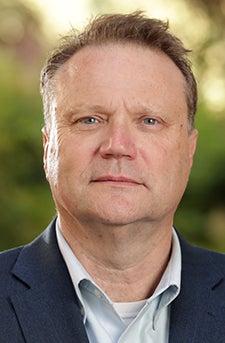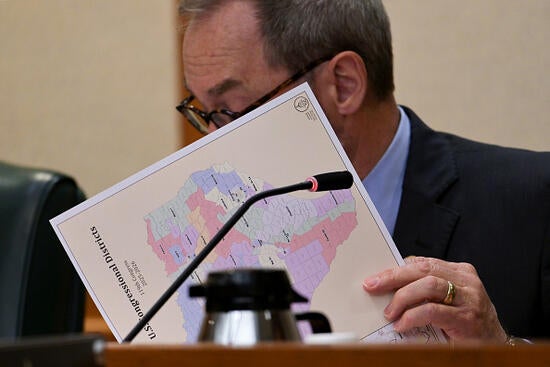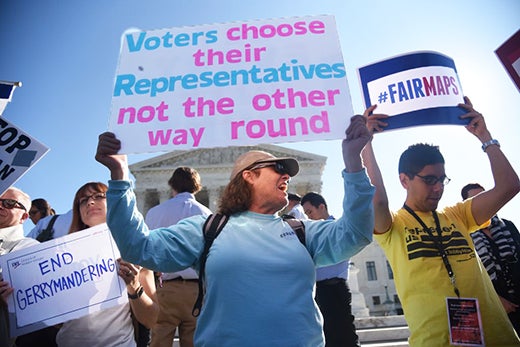When politicians redraw congressional district maps to favor their party, they may secure short-term victories. But those wins can come at a steep price — a loss of public faith in elections and, ultimately, in democracy itself.
That’s the conclusion of a peer-reviewed study led by UC Riverside political scientist Shaun Bowler, published in Political Research Quarterly. The research finds that partisan gerrymandering — the manipulation of district boundaries to lock in political advantage — does more than distort representation in Congress. It undermines the belief that elections are fair, a cornerstone of democratic legitimacy.
Bowler, a professor of political science, said survey data from tens of thousands of voters in the 2020 and 2022 elections show that Americans view gerrymandering with the same disdain they reserve for bribery and other blatant forms of political corruption. The difference, he said, is that gerrymandering is carried out in full public view, cloaked in arguable legality.
Consider the current push in Texas, where Republican legislators and Gov. Greg Abbott, encouraged by President Donald Trump, are working to redraw congressional districts to add five GOP seats as part a Republican effort to retain control of Congress after next year’s midterm election.
“It’s out in the open,” Bowler said. “They’re saying, ‘We’re rigging the midterm election to produce an outcome.’”
Even for voters whose party benefits, such victories can feel hollow.
“Voters think, ‘What did we win? These people were elected by a rigged outcome, and now they’re going to tell me what’s good for the community?’” Bowler said.
When people believe elections are predetermined by politicians, rather than decided by voters, they may be less inclined to donate to candidates, volunteer, or even show up at the polls.
Bowler’s findings suggest the disillusionment crosses party lines.
“Even if you’re a Republican in Texas, you know cheating went on,” he said. “If the referee is always on your side, did you really win the game? When a representative wins this way, it is like being a sports figure whose stats always have an asterisk by their name to convey that there will always be doubts about them.”
This erosion of legitimacy can ripple far beyond Election Day. “If they didn’t win fair and square, why should I believe what they say? Why should I pay my taxes? You get an erosion of civic behavior,” Bowler said.
The study also connects gerrymandering to broader perceptions of corruption. While bribery is often the image that comes to mind, Bowler calls self-serving map drawing a form of “improper benefit” that voters also instinctively see as wrong. In states with histories of political scandal, the association is even stronger.
Bowler and co-author Todd Donovan of Western Washington University in Bellingham examined how state-level conditions influence trust in elections. They used the Survey on the Performance of American Elections (SPAE), conducted by the MIT Election Data and Science Lab, which asks voters how confident they are that votes were counted as intended in their state and nationwide.
The study zeroed in on confidence in state vote counts since election administration quality and other election processes are measured at the state level. The 2020 SPAE surveyed 18,200 registered voters, with at least 200 from every state and the District of Columbia, and larger samples in 10 states. The 2022 survey included 10,200 voters, with similar sampling. Both were conducted by YouGov and weighted to reflect the national voting population.
Researchers linked these responses to the MIT Elections Performance Index, which scores states on ballot rejection rates, post-election audits, online voter tools, and other measures. They also considered corruption, measured by U.S. Department of Justice conviction rates for public officials from 2011 to 2020.
Partisan gerrymandering was measured using the “Efficiency Gap” to show how much maps favor one party. It compares each party’s “wasted votes” (votes that don’t help win a seat, either because they are cast for a losing candidate or are excess votes beyond what was needed to win) across all districts in a state. If one party consistently wastes far fewer votes than the other, the map boundaries are giving it a systematic advantage. The larger the gap, the greater the partisan bias baked into the district lines.
The study — “Corruption, gerrymandering and perceptions of election integrity: Is there more than confidence than partisanship? — also accounted for state party control, whether a state was a late-counting swing state in 2020, voters’ partisanship, demographics, and, when available, perceptions of election officials’ fairness.
Using multilevel statistical models, the researchers found that state-level conditions shape not only confidence in a state’s own vote counts but also perceptions of national results.
Independent redistricting commissions offer one way to rebuild trust, Bowler said. California’s voter-approved commission has earned praise for removing the process from the hands of lawmakers. Another option is proportional representation, in which parties win seats based on their share of the statewide vote, rather than in winner-take-all districts, Bowler said. While no system can fully remove politics from redistricting, Bowler argues that these reforms could weaken the perception that lines are secretly drawn to favor insiders.
“Democracy depends not only on fair rules,” he said, “but also on the belief that those rules are fair.”
Header photo: A woman views views a U.S. congressional district maps at the Texas State Capitol on August 6, 2025 in Austin, Texas. (Photo by Brandon Bell/Getty Images)
Source link





